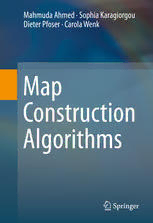
Map Construction Algorithms PDF
Preview Map Construction Algorithms
Mahmuda Ahmed · Sophia Karagiorgou Dieter Pfoser · Carola Wenk Map Construction Algorithms Map Construction Algorithms Mahmuda Ahmed • Sophia Karagiorgou Dieter Pfoser (cid:129) Carola Wenk Map Construction Algorithms 123 MahmudaAhmed SophiaKaragiorgou DepartmentofComputerScience SchoolofRuralandSurveyingEngineering UniversityofTexasatSanAntonio NationalTechnicalUniversityofAthens SanAntonio,TX,USA Zografou,Greece DieterPfoser CarolaWenk DepartmentofGeography DepartmentofComputerScience andGeoinformationScience TulaneUniversity GeorgeMasonUniversity NewOrleans,LA,USA Fairfax,VA,USA ISBN978-3-319-25164-6 ISBN978-3-319-25166-0 (eBook) DOI10.1007/978-3-319-25166-0 LibraryofCongressControlNumber:2015953323 SpringerChamHeidelbergNewYorkDordrechtLondon ©SpringerInternationalPublishingSwitzerland2015 Thisworkissubjecttocopyright.AllrightsarereservedbythePublisher,whetherthewholeorpartof thematerialisconcerned,specificallytherightsoftranslation,reprinting,reuseofillustrations,recitation, broadcasting,reproductiononmicrofilmsorinanyotherphysicalway,andtransmissionorinformation storageandretrieval,electronicadaptation,computersoftware,orbysimilarordissimilarmethodology nowknownorhereafterdeveloped. Theuseofgeneraldescriptivenames,registerednames,trademarks,servicemarks,etc.inthispublication doesnotimply,evenintheabsenceofaspecificstatement,thatsuchnamesareexemptfromtherelevant protectivelawsandregulationsandthereforefreeforgeneraluse. Thepublisher,theauthorsandtheeditorsaresafetoassumethattheadviceandinformationinthisbook arebelievedtobetrueandaccurateatthedateofpublication.Neitherthepublishernortheauthorsor theeditorsgiveawarranty,expressorimplied,withrespecttothematerialcontainedhereinorforany errorsoromissionsthatmayhavebeenmade. Printedonacid-freepaper SpringerInternationalPublishingAGSwitzerlandispartofSpringerScience+BusinessMedia(www. springer.com) To Myparents,JamiulandRaif –Mahmuda Mylovedones –Sophia Nektaria,Daphne,andAlexandros –Dieter Joe,Dagmar,andK.-U. –Carola Preface Streetmapsandtransportationnetworksareoffundamentalimportanceinawealth of applications. In the past, the production of street maps required expensive field surveying and labor-intensive post-processing. Proprietary data vendors such as NAVTEQ(nowNokia),TeleAtlas(nowTomTom),andGooglethereforedominated themarket.Inrecentyearsvolunteeredgeographicinformation(VGI)effortssuch as OpenStreetMap (OSM) have complemented commercial map datasets. They provide map coverage especially in areas that are of less commercial interest. VGIeffortshowever stillrequirededicated userstoauthor mapsusingspecialized software tools. Lately on the other hand, the commoditization of GPS technology, itsintegrationinmobilephones,andtheadventoflow-costfleetmanagementand positioning applications have triggered the generation of vast amounts of tracking data. As a size indicator one can consider the contribution of tracking data in OpenStreetMap, which is steadily increasing and currently amounts to 2.6 trillion points.Besidestheuseofsuchdataintrafficassessmentandforecasting,i.e.,map- matchingvehicletrajectoriestoroadnetworkstoobtaintraveltimes,therehasbeen arecentsurgeofactualmapconstructionalgorithmsthatderivenotonlytraveltime attributesbutactualroadnetworkgeometriesfromtrackingdata. The ambition of this book is to provide the reader with an introduction to map construction algorithms. Providing a research overview is a challenging task since map construction is a very active research field. We address this conundrum by identifying and focusing on three emerging categories of map construction algorithms. For each category we present the general algorithmic idea and a high- leveldescriptionoftherespectivealgorithms.Forthisbooktoalsoserveasastarting point for map construction research, an in-depth discussion of relevant algorithms is essential. Here, we selected three respective methods, one for each category of algorithms. Devoting one chapter per method, we provide a detailed description thatcanserveasabasisforsubsequentresearch. Amajorchallengeintheresearchcommunityistocomparetheperformanceand toevaluatethequalityofcompetingalgorithms.Theoutcomeofmapconstruction is a map dataset that should be close to an actual map data geometry. The quality of an algorithm can thus be measured by the accuracy of its respective result. vii viii Preface Visual inspection has been the most common evaluation approach throughout the literature since it gives an intuitive way of assessing the quality of a map. Parts of this book are dedicated to showcasing map construction results from different algorithms to provide the reader with a simple means to assess the strengths and weaknessesofmapconstruction.Onlyafewrecentworksincorporatequantitative distance measures to assess the quality of map construction results. The cross- comparison of different algorithms remains rare, since algorithms and constructed mapsaregenerallynotpubliclyavailable.Inaddition,thereisalackofbenchmark dataandthequantitativeevaluationwithsuitabledistancemeasuresisinitsinfancy. This book discusses the range of existing methods to assess the quality of the constructedmaps.Thesemethodsarenotonlydiscussedintermsoftheirtheoretical characteristics but are also used with different tracking datasets to quantify the qualityoftheproducedmaps. The datasets used in the evaluation were created by tracking vehicle fleets in threelargecities.Weuseddatasetsfromdifferentcitiestocoverdiverseroads(i.e., highwaysandsecondaryroads),differentsamplingrates,anddifferentscales. In addition to providing a comprehensive comparison of map construction algorithms, we make the mentioned datasets, map construction algorithms and outputs,aswellastheevaluationmethodspubliclyavailableontheInternetathttp:// www.mapconstruction.org/. We have established this Web site as a repository for mapconstructiondataandalgorithms,andweinviteotherresearcherstocontribute byuploadingcodeandbenchmarkdatasupportingtheirmapconstructionwork.We expect that such a central repository will encourage a culture of sharing and will enablethedevelopmentofimprovedmapconstructionalgorithms. OrganizationofThis Book This book seeks to outline the basic principles of map construction algorithms. It deals with the concepts, techniques, and specifically algorithms that have been developed in recent years. An introductory chapter is the basic reference point for all types of readers including practitioners, scientists, and graduate students. The reader will gain an overview of the research ambition so as to also assess the potential of map construction algorithms in her respective field. Beyond covering basic categorization and overview, subsequent chapters give an in-depth analysis of specific techniques. This discussion of map construction algorithms as well as evaluationmethodstargetsresearchersinterestedinadvancingthefield.Thosechap- ters in connection with the accompanying Web page http://www.mapconstruction. org/ allow for a quick assessment of the state of the art in map construction. The reader is able to download source code and run the algorithms using provided exampledatasetsbasedoninstructionsdetailedinauserguidechapterinthisbook. The interested reader will find, at the end of each chapter, a section devoted to bibliographic notes. The book is organized in nine chapters, whose content is as follows. Preface ix (cid:129) Chapter 1 gives an overview of map construction algorithms and groups them intothreemaincategories. (cid:129) Chapter 2 describes the TraceBundle algorithm as a proponent of intersection linkingalgorithmsindetail. (cid:129) Chapter 3 gives a description of an incremental track insertion algorithm that utilizestheFréchetdistance. (cid:129) Chapter 4 presents an example of a density-based map construction algorithm andshowcasestheuseofapipelinewithmultipleintermediatesteps. (cid:129) Chapter 5 visualizes a range of trajectory datasets, reference maps, and map constructionresults. (cid:129) Chapter6introducesarangeofmethodstoassessthequalityoftheconstructed maps. (cid:129) Chapter 7 is devoted to an experimental evaluation and to establish general performancecharacteristicsofthethreealgorithms. (cid:129) Chapter 8 discusses nontraditional uses for map construction algorithms, i.e., scenarios in which constructing a “map” would provide further insight into the data. (cid:129) Chapter 9 provides a user guide for the three map construction algorithms described in detail in this book. The guide shows how to use the actual code andtoproducemapsbasedonincludedtrajectorydata. Thebookhasseveralpotentialaudiences.Thefirstaudienceincludesinterested practitioners from the geospatial data management community trying to use map construction as a means to simplify and aggregate trajectory datasets. This work will have respective data mining algorithms as its ultimate goal, i.e., to perform data analysis on massive amounts of trajectory data. Another audience consists of graduatestudentsandresearchersinterestedinextendingthecurrentstateoftheart inmapconstructionresearch.Thisincludes,forexample,computationalgeometry researcherspursuingthemapconstructionchallengefromatheoreticalperspective and aiming for algorithms that provide quality guarantees. We tried as much as possible to cater to both audiences by having overview and example chapters as well as an in-depth discussion of specific methods and specific experimental results. Practitioners will be more interested in Chaps.1, 5, 8, and 9, which provideanoverviewofmapconstructionalgorithms,visualizesomeresults,discuss new application areas, and provide a user guide, respectively. A more detailed discussion of the algorithms is provided in Chaps.1–4, with evaluation measures andexperimentalresultsbeingdiscussedinChaps.6and7,respectively.Inaddition, thededicatedWebpageandrespectiveuserguideofChap.9shouldallowthereader tostartworkingwiththevariousalgorithmsrightaway.
